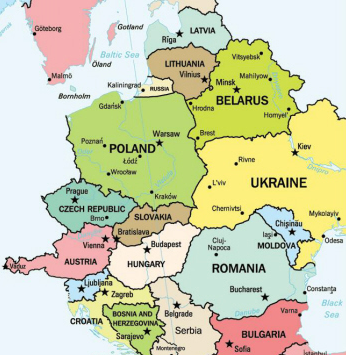
Eastern Europe – the epicenter of our next crisis?
It’s official. European consumer prices fell an annual 0.2 per cent in December 2014. German five-year bonds and Swiss ten-year bonds are now paying a “negative rate of interest.” European Central Bank (ECB) president Mario Draghi continues to “do whatever it takes” with last week’s announcement of the 1,100 billion euro (US$1,250 billion) bond purchase program over 2015 and 2016. Mario thinks this will steer the Euro area away from deflation by convincing investors his latest strategy is audacious enough to stimulate their relatively fragile economy.
With the plunging oil price and the hard left Syriza Party taking government in Greece this week, Greece’s repayment schedule and austerity program is being questioned. Mario seems a little bit trapped, given the average ten-year sovereign bond yield for France, Germany, Italy, Portugal, Spain and The Netherlands is currently 1.15 per cent, well below the US ten-year bond yield of 1.7 per cent. While Mario thinks the lower the bond yield for these major economies, the better the outlook, all that seems to be happening is the decline of the Euro/ US dollar exchange rate to an eleven year low. This is after six years of Quantitative Easing, may as well make it eight years!
The European Union 28 member state, according to German Chancellor Angela Merkel; accounts for only 7 per cent of the world’s population, 25 per cent of the world’s GDP but 50 per cent of the world’s social spending. Demographics are challenging with more people in the 65 years and older category than in the under 15 year category, while the 500 odd million population is forecast to remain relatively steady over the long-term.
Academics Carmen Reinhart and Kenneth Rogoff claim that if a country’s external debt to GDP ratio exceeds 30 per cent, there is a material risk of a credit default. Based on information from Joint External Debt Hub (www.jedh.org), there are 25 countries believed to exceed this ratio. Interestingly, 19 of them are based in Eastern or Southern Europe, with Greece easily winning the gold medal with a gross external debt to GDP ratio of 210 per cent.
Any crisis in Eastern Europe will have negative ramifications for the European Union. Countries like Romania, Ukraine, Poland, Belarus and Turkey have a combination of high current account deficits and high external indebtedness. Also, any exchange rate devaluation would increase pressure to service more foreign currency debt, not unlike the Swiss Loans, which was pumped into Aussie farmers in the mid-1980s. At least the external debt of Greece, Latvia, Slovenia, Estonia and Slovakia is predominantly denominated in Euro.
Meanwhile, the Russian Federation is suffering from the oil price crash and international sanctions. Moody’s Investors Services just lowered Russia to Baa3, the lowest investment grade and Standard & Poor’s has just cut their sovereign credit rating to junk. Currently one in every five distressed corporate bonds worldwide originates from Russia, and with the central bank hiking the cash rate from 10.5 per cent to 17.0 per cent in late-2014, the sixth increase in a year, it appears a serious recession in 2015 is likely.
Furthermore, the tension between the Ukraine and Russia and the threat to bypass the Ukraine for Russia’s gas exports, which supplies around one-third of Europe’s needs, is escalating.
Finally, back to the European Central Bank president Mario and the audacious 1,100 billion Euro package to be implemented over 2015 and 2016. This package of Quantitative Easing has added some recent enthusiasm to markets. But as we have seen with both Greece and Cyprus in the recent past, this may not prevent default in parts of Eastern Europe, the likely epicenter of our next crisis. Meanwhile, the Athens Stock Exchange General Index declined 9.2 per cent overnight to be down nearly 50 per cent since early 2014.
To learn more about our funds, please click here, or contact me, David Buckland, on 02 8046 5000 or at dbuckland@montinvest.com
Aaron Somner
:
Hi David, I was wondering if you could answer a question for me. The yields on these government bonds are at all time record lows which would mean that the prices of these bonds are at all time record highs? Does this indicate a bubble? Also if bonds are effectively cash that pays interest would this indicate that there is a bubble in quasi term deposits? Would this explain the deflation that is present around the world as money is actually parking instead of investing? Thanks A.S
David Buckland
:
You are right Aaron.
Interest rates are at record lows and this is due to a combination of Quantitative Easing, the easy policies implemented by the various Central Banks and deflation being recorded in a number of European economies.
I am sure that when there are signs of some inflationary pressures, which we may see if unemployment in the US continues to decline, and average weekly earnings starts to recover, then we will know bond yields are in a bubble.
Chris B
:
The bonds in some countries of 1.15% seem like return free risk (instead of risk free returns). Portugal and Germany did a lot of renewable energy subsidies in the last 5 or more years. Solar and wind is much cheaper than it was 5 years ago. Portugal and Germany now get something like 60% of their energy from renewables so it is interesting how that will affect their economy. Its not baseload power but still it’s 60%. They have been vocal about nuclear after Fukishima and cut plans to develop some nuclear plants.
The countries relying mostly on oil for income will suffer but this has happened over the years, they’ve been through it before. They suffer for a bit then they recover.